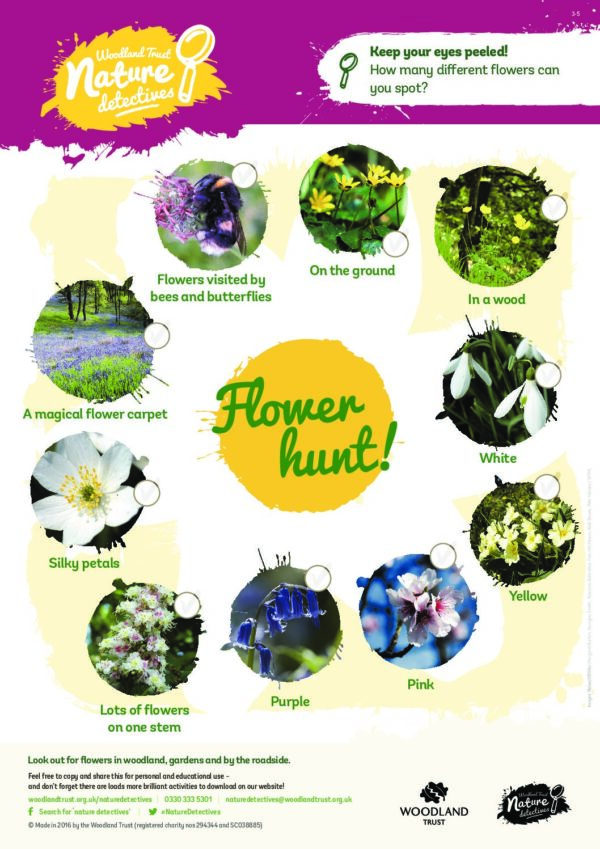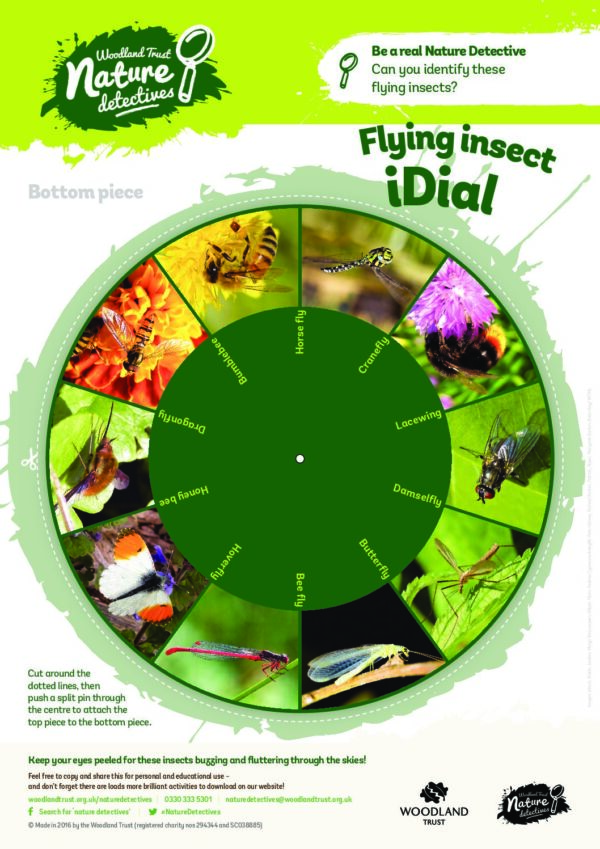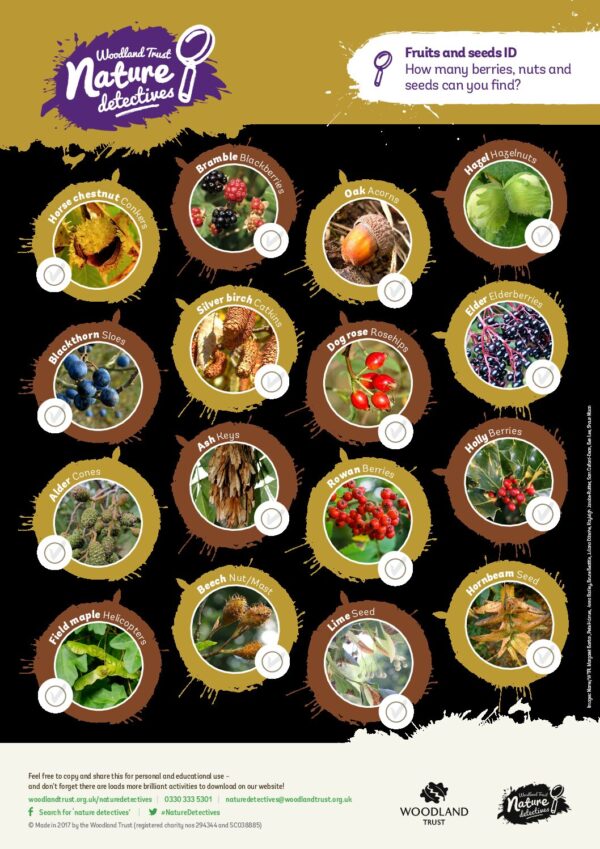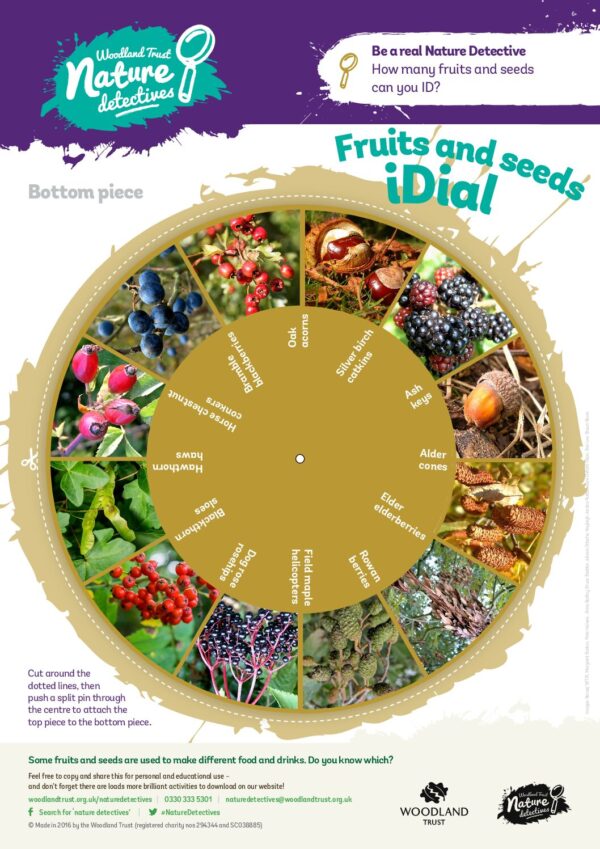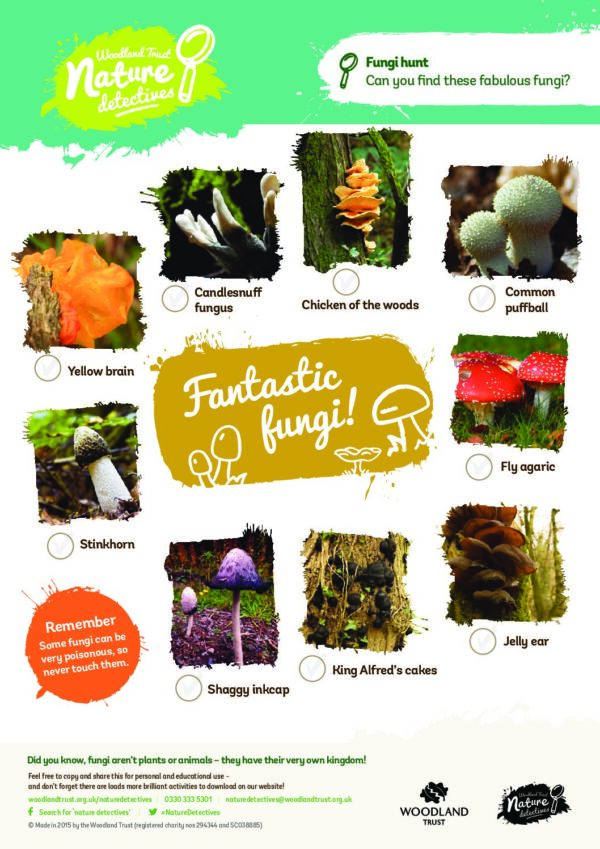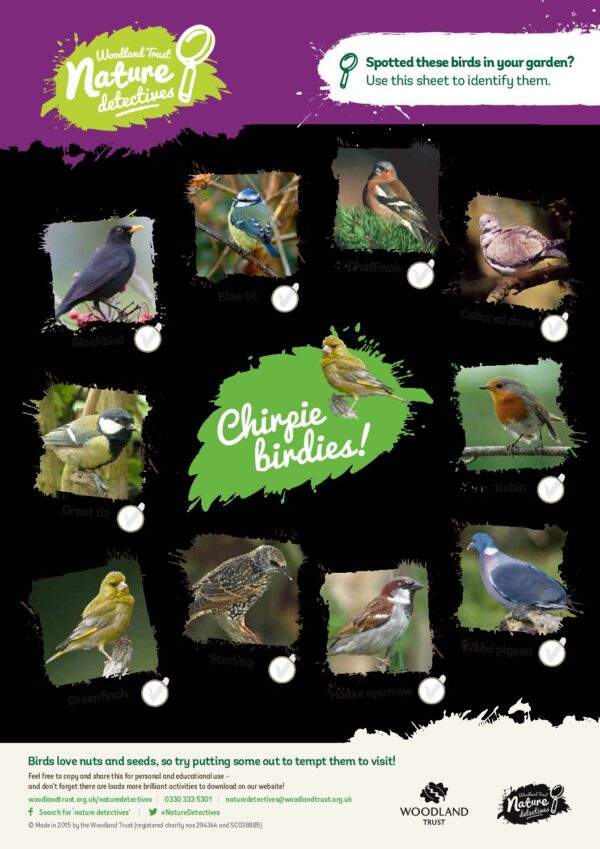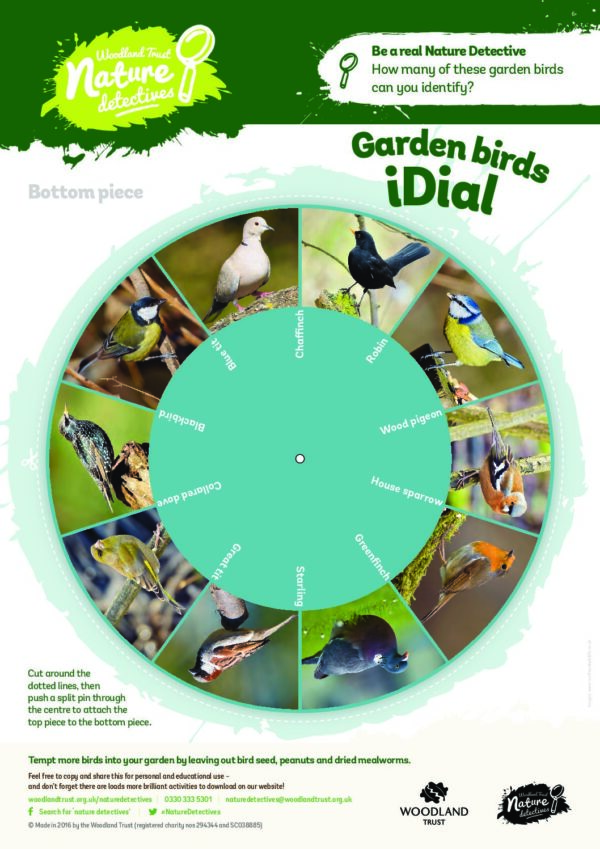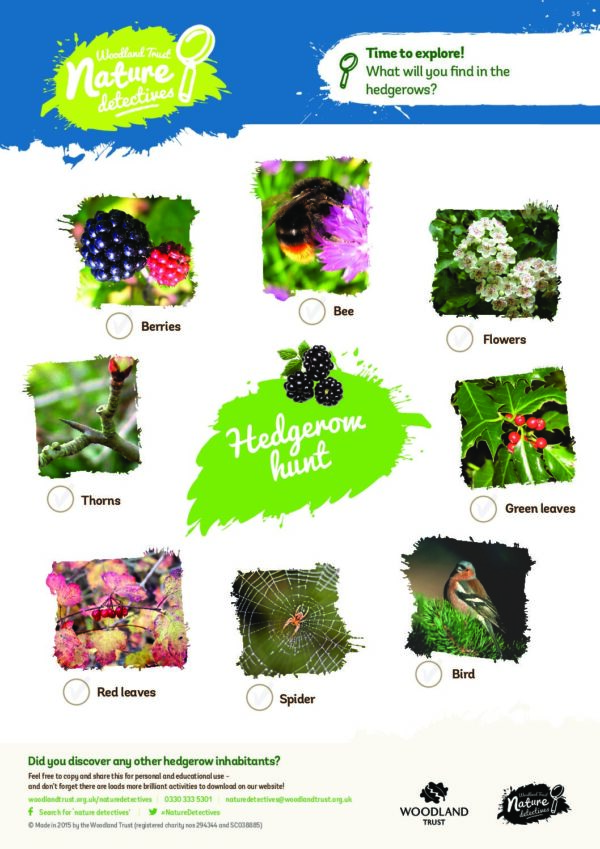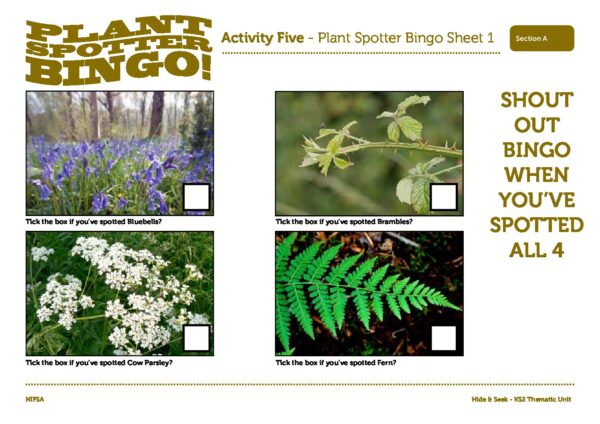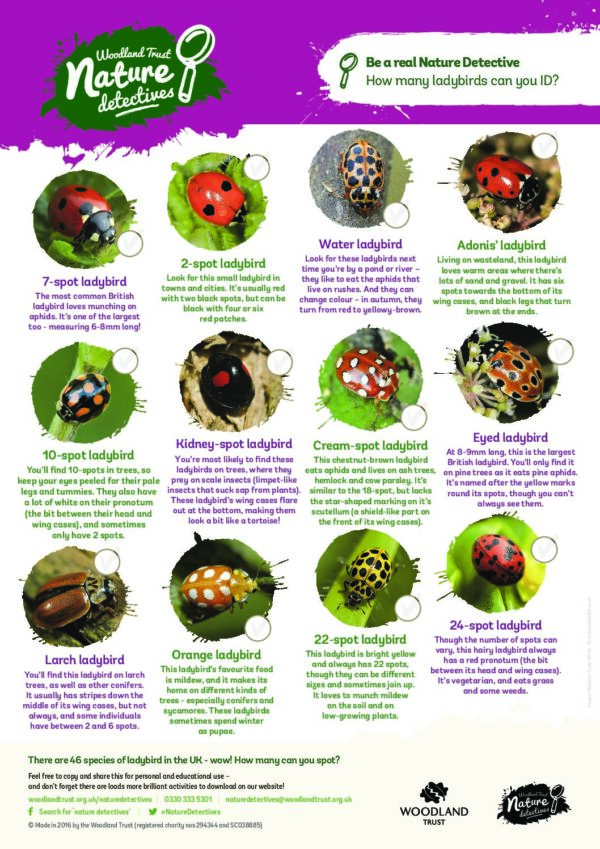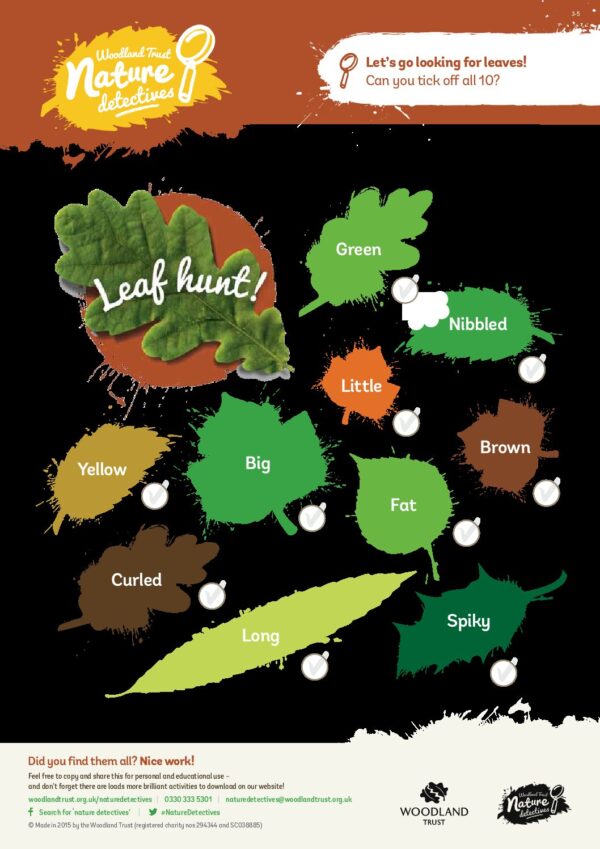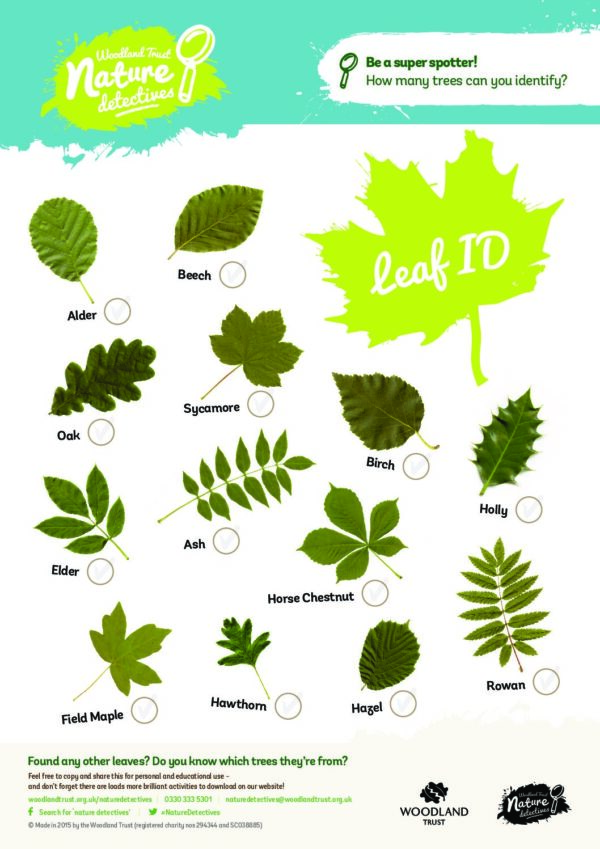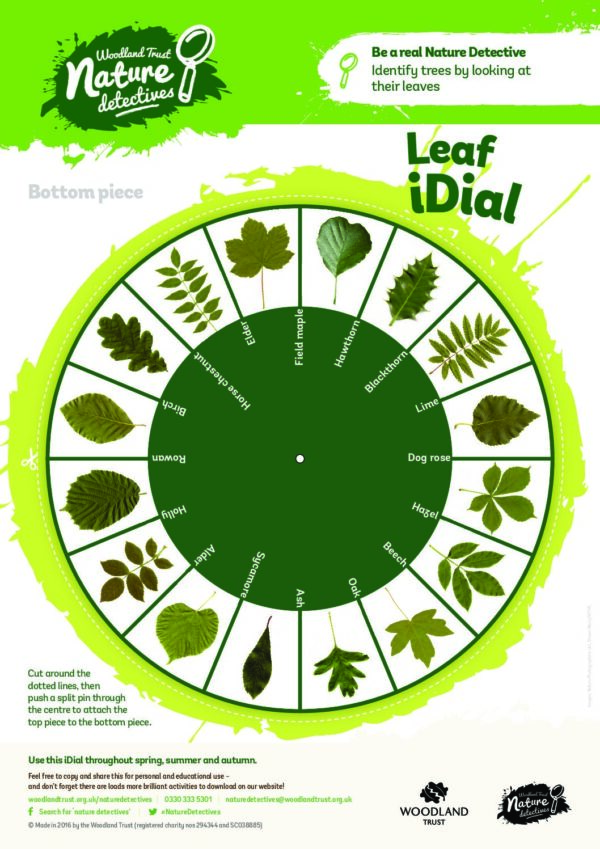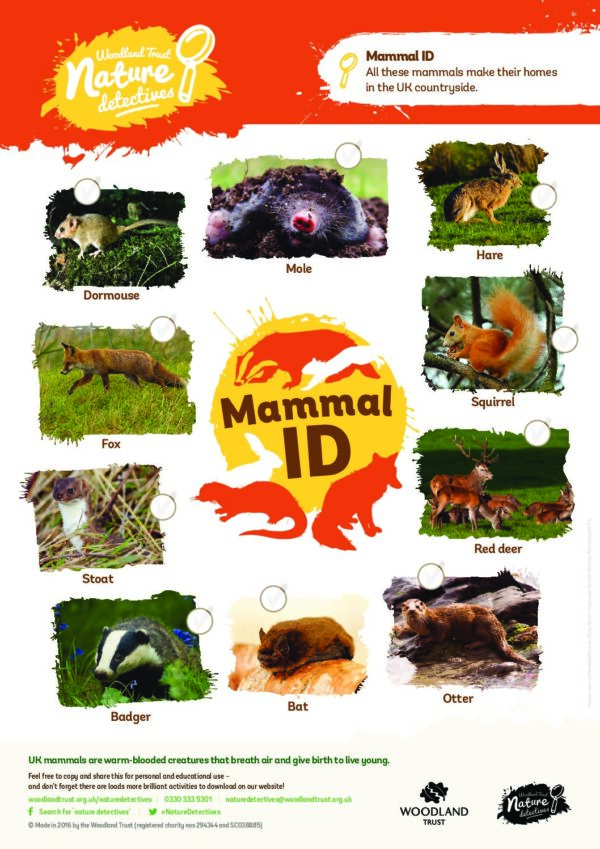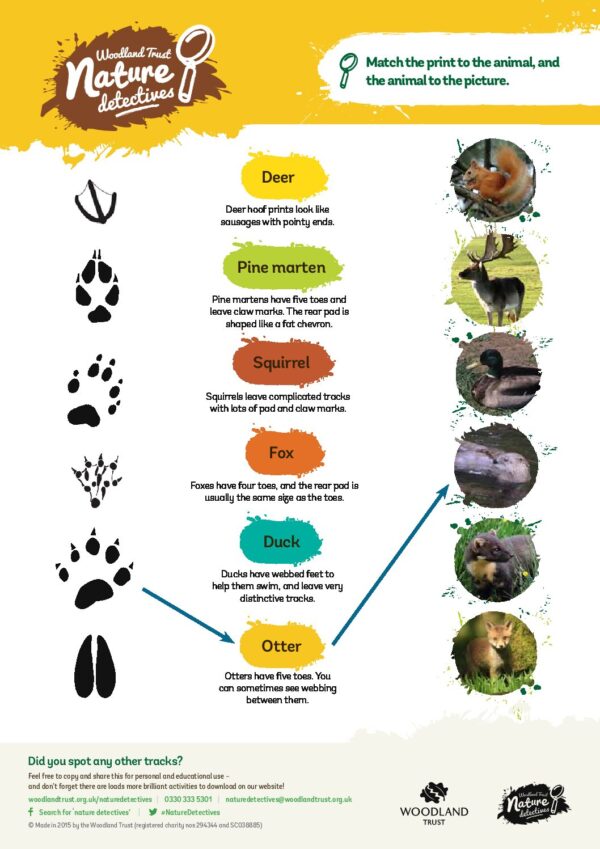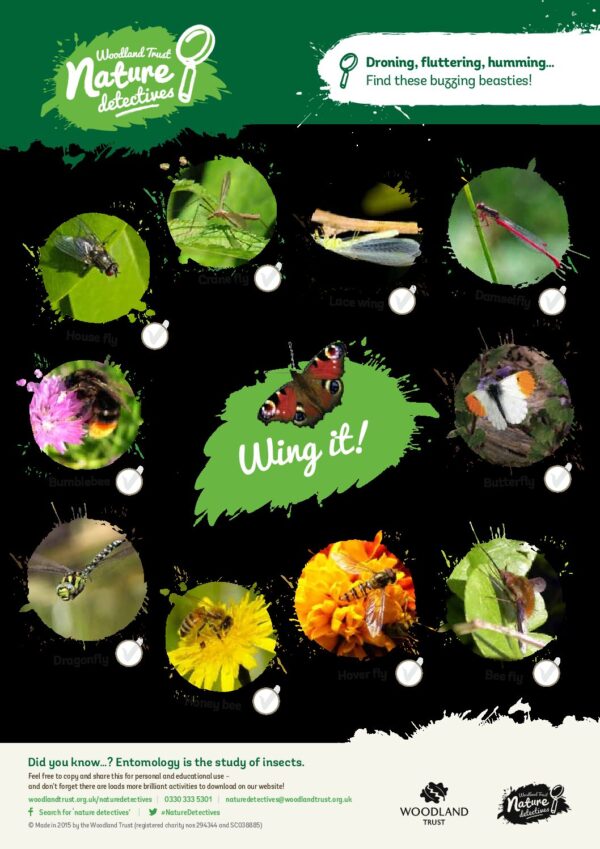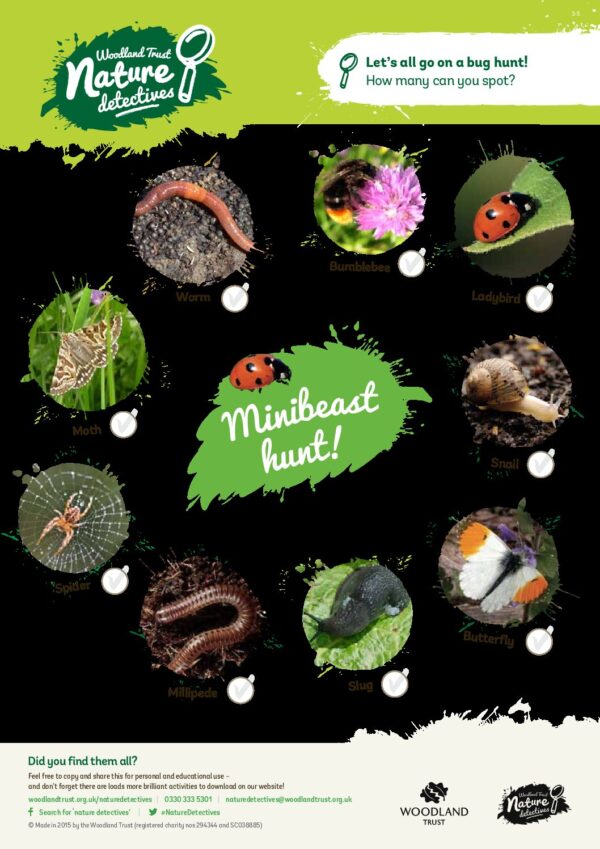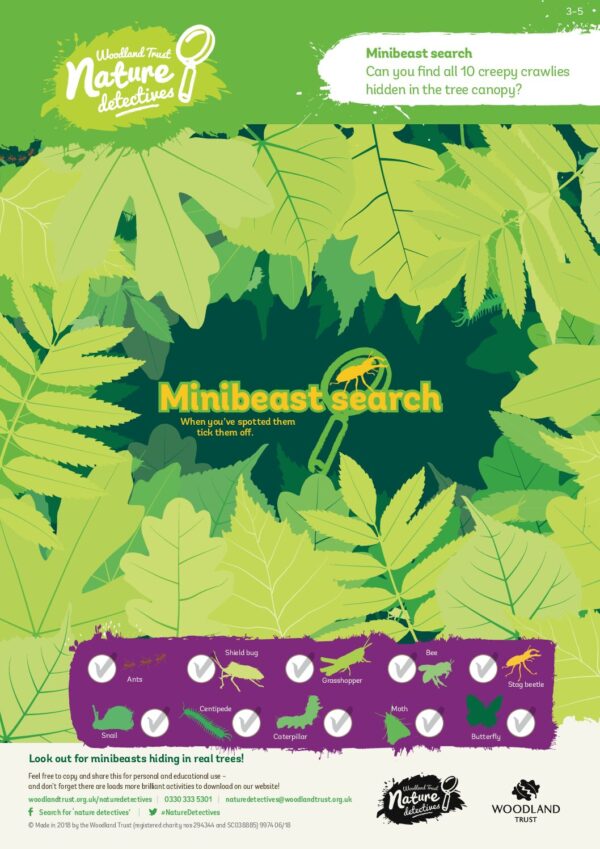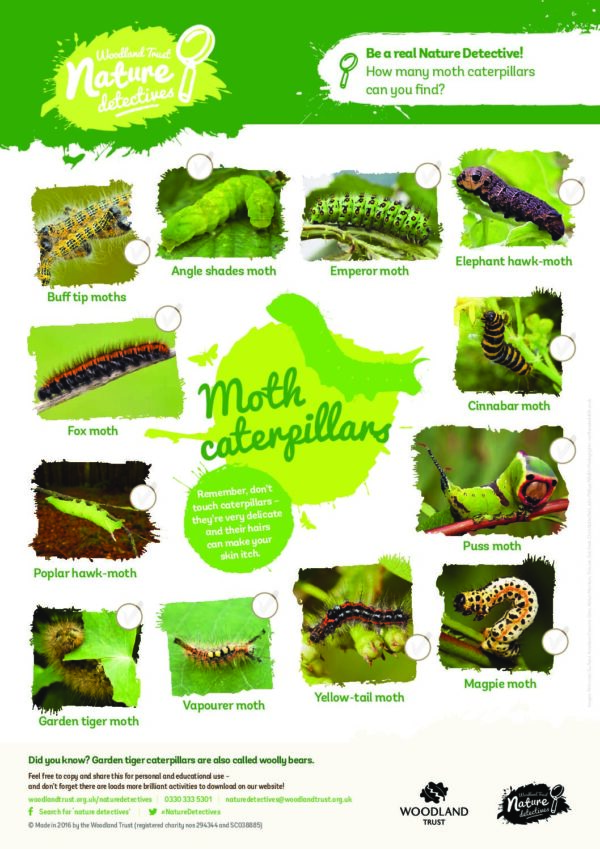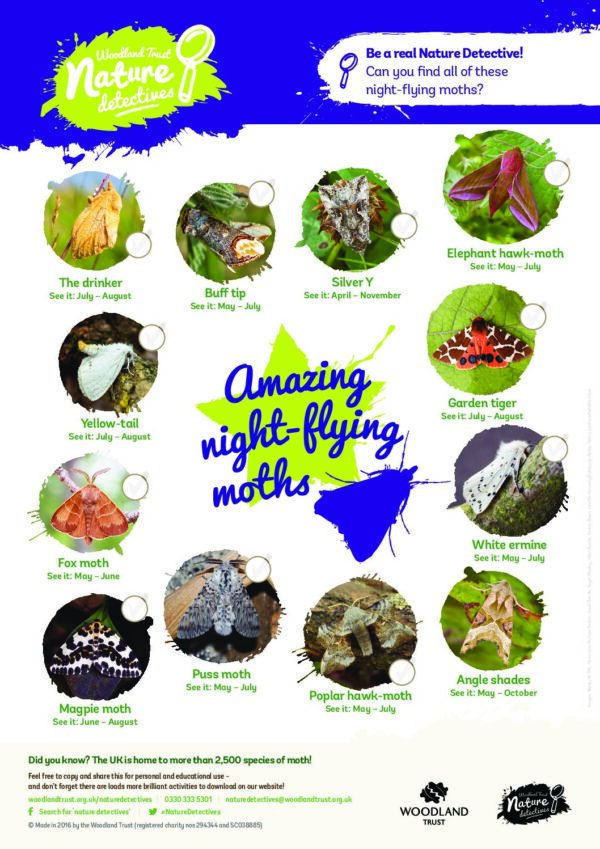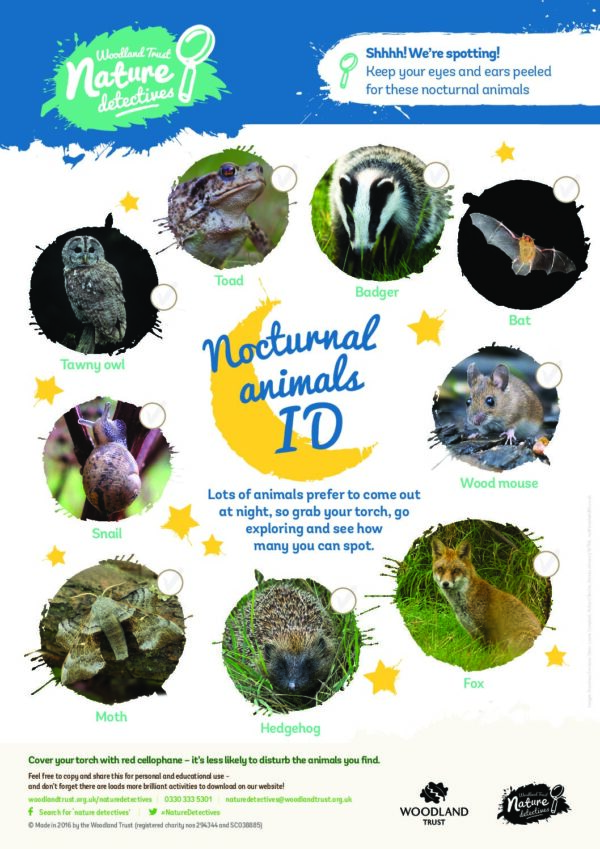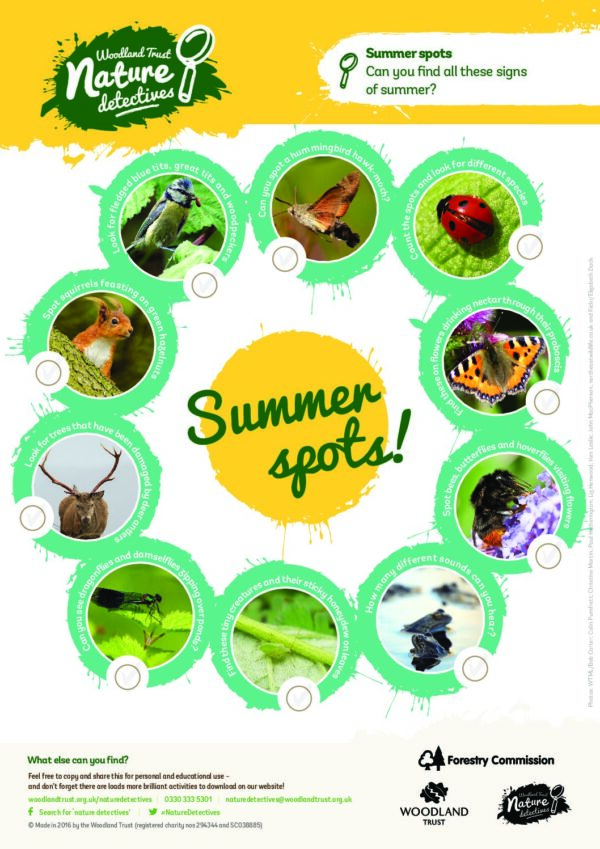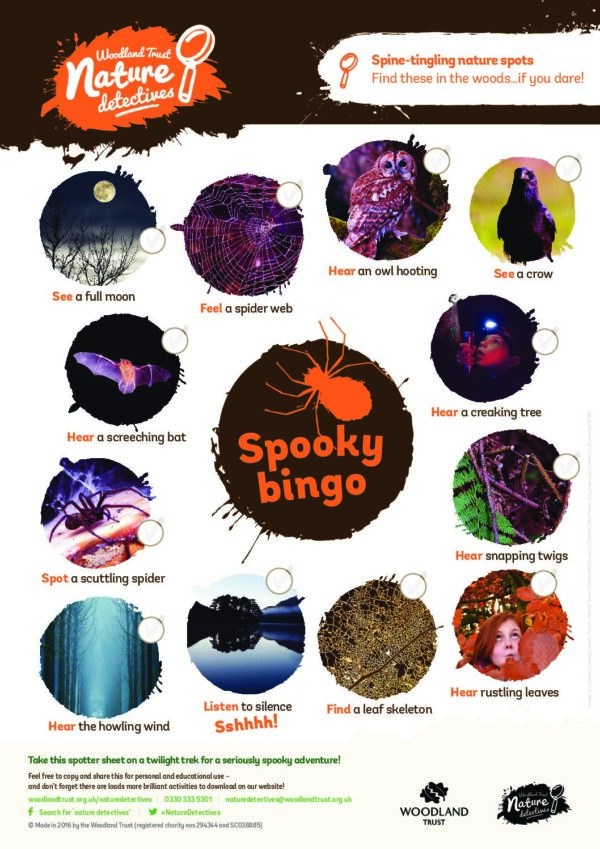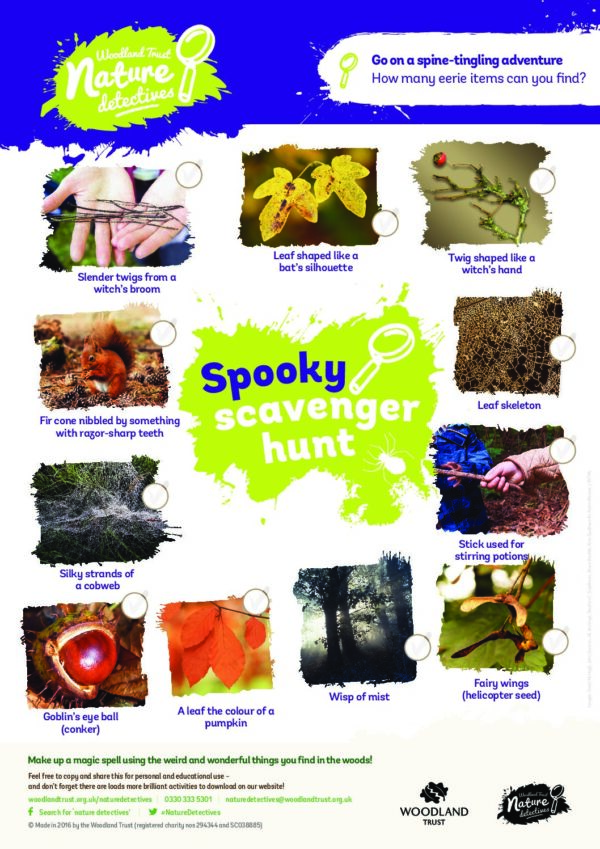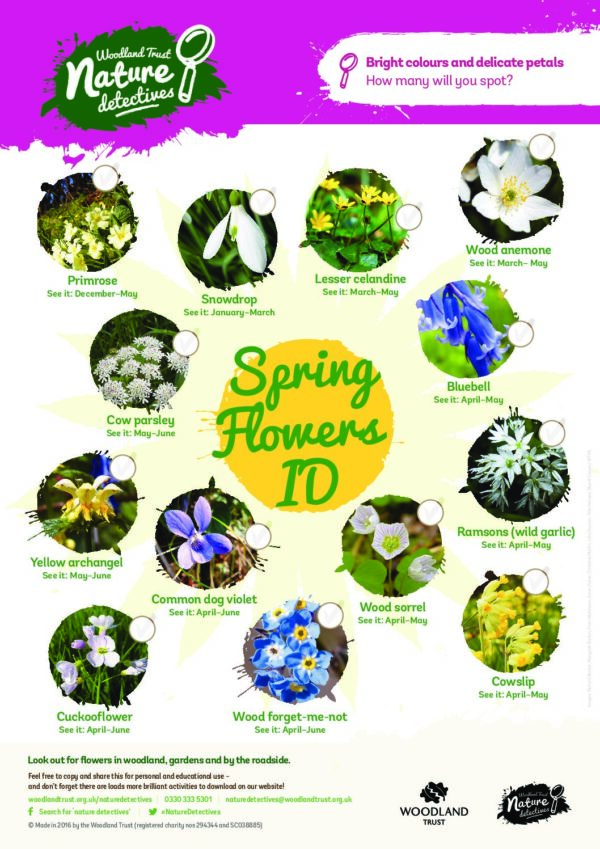spotter sheet
Head outdoors and see how many flowers you can find. Flowers burst into life during spring and summer. That makes it a great time to set off on a flower hunt. Are there any busy bees or fluttering butterflies among the petals? Some flowers turn into fruit, like raspberries, strawberries and blackberries Try using fallen leaves and petals to make your own flowers Flowers come in all colours, shapes and sizes
Look to the skies and ID these flying insects. Use your iDial to help you name the insects you spot. Look around ponds and streams, as well as flowers and plants How many different flying beasties can you spot? Keep your eyes peeled while you’re in the garden and the woods Don’t forget to take this iDial with you while you’re out and about.
Hunt for these fruits and seeds in woods during late summer and autumn. How many can you identify? Look to the trees, bushes and hedgerows and see how many different fruits and seeds you can spot. Seeds come in lots of shapes and sizes, including berries, cones, keys and catkins Lots of tasty food and drink can be made from fruits and seeds Do you know how they re scattered? Fruits and seeds can help you ID trees and bushes, so keep your eyes peeled. Remember, lots of fruits and seeds will have fallen to the ground.
This iDial is great for identifying fruits and seeds while you’re out and about. Ready to get detecting? How many fruits and seeds can you spot and ID? Hunt for these fruits and seeds in spring, late summer and autumn Can you guess how they are scattered? They can help you ID trees, shrubs and bushes Fruits and seeds come in all different shapes and sizes, and some are even used to make tasty food and drink. Do you know which?
Go hunting for fantastic fungi. Fungi can grow in all sorts of places: in the woods, in the park even in your garden. Some fungi are brightly coloured, some are brown which is your favourite? Did you know that some fungi smell sweet and others smell rotten? Search for mushrooms under leaf litter and on dead wood Remember some fungi can be very poisonous, so never touch them.
Identify the birds that visit your garden with this handy spotter sheet. All sorts of birds make their homes in your garden. Now it’s time to see how many you can spot. Are you up to the challenge? Use nuts and seeds to tempt different birds to visit Look on your ID sheet and tick off each bird you see in your garden Remember to leave water out for birds to drink and wash in too Try experimenting with different foods. Try nuts, seeds and dried mealworms and see which birds prefer which foods. Are there any that come back time and time again?
Use this iDial to help you identify the birds visiting your garden. Be a real Nature Detective! How many birds will you spot? Go on a garden bird hunt and find out which birds visit your garden Tempt more birds to visit by leaving nuts, seeds and fat balls out for them Have you noticed any other birds coming to your garden? Take this iDial with you when you’re out and about, and see which birds you see on your travels. Are they similar to the birds visiting your garden?
Go hunting in the hedgerows and see what you can find. Look out for hedgerow inhabitants while you’re out and about. How many can you spot? Search among the leaves, grass and brambles Use your senses what can you hear, see, touch, smell? Does anything else make their home in the hedgerows? Go hunting early on a foggy, frosty morning and spot glittering spider webs.
Hide and Seek Plant Thematic Unit Resources
Go on a ladybird hunt and use our handy ID sheet to identify your discoveries. Seven spots, twenty two spots, some even have stripes! How many different ladybirds can you find? Ladybirds live in lots of different places in trees, by ponds and in your garden They re known as the gardener’s friend as many of them munch on aphids – a garden pest Ladybirds aren’t always red they can be orange, yellow, brown even black! Did you know there are 46 species of ladybird in the UK?
Find all the lovely leaves on this super spotter sheet. Take this spotter sheet with you when you’re out and about. Can you find all the leaves? Look for leaves on the ground and in the trees Have you spotted more long, fat, spiky or curled leaves? Which is your favourite type of leaf? Try collecting the different types of leaves you find. Perhaps you could take them home and use them to make a lovely leafy picture?
Learn about the trees in your garden, street or local wood. Here’s our handy leaf ID sheet. It has 13 common British trees on it, including oak, hazel and holly. Use it identify leaves on trees and on the ground. Look at leaf shapes and sizes. How are they different? Some leaves change colour in autumn. Find out why. Did you find all the leaves on the sheet?
A handy tool to help kids identify trees found in the UK. Print and make the leaf iDial, then take it with you on your next adventure. How many different leaves can you find? Look out for leaves during spring, summer and autumn Challenge your friends to see who can find each leaf first! Try guessing which tree or shrub a leaf belongs to, then check the iDial to see if you were right! Did you know? Leaves are large and flat to help them absorb sunlight and carbon dioxide, which they turn into food to help trees and plants grow.
How many of these mammals can you spot? Some of these animals might be tricky to find, but they all live in the UK. If you’re lucky, you might spot one, but remember to keep your eyes peeled for other signs like footprints, fur and poo! Some of these mammals are nocturnal, which means they only come out at night Many mammals live a lot closer to you than you think foxes and squirrels sometimes make their homes in towns and cities as well as the countryside Which mammal is your favourite?
Spot these tracks on your travels – do you know which animal they belong to? Be a real Nature Detective! Keep your eyes peeled for prints while you’re out and about Look out for footprints in soft ground It’s best to spot tracks in snow or after a rain shower Have you spotted any other tracks? Where did you find them
Use this spotter sheet to help you identify flying insects. Look to the skies and see how many of these winged minibeasts you can see. Some insects buzz, some flutter and some hover how many of each can you find? Look in different habitats like woods, meadows and by rivers and ponds Can you spot any insects resting on leaves in the sunshine? Be careful when hunting minibeasts they can be delicate, so if you pick one up to get a closer look, be gentle.
When you’re off adventuring, use this spotter sheet to hunt for minibeasts. There’s no better time to head out on a marvellous minibeast hunt! Look for creepy crawlies under logs and stones Spot insects in the air Do they come out in the sunshine or after rain? Be a real Nature Detective! Next time you go to the woods or play in your garden, try and find these minibeasts. Where do they like to hide? How many did you discover?
Can you find the creepy crawlies hiding in the tree canopy? You’ll need your best detective skills for this activity! Download the colourful puzzle sheet and see if you can find all 10 minibeasts hiding among the leaves. Think you’ve found them all? Check your answers. When you’ve finished, head outside and look at a real tree. What can you spot crawling over bark and lurking underneath leaves?
Find and identify these moth caterpillars. Moths start life as caterpillars. Take this ID sheet with you next time you’re out and about, and see how many moth caterpillars you can find. Some moth caterpillars are covered in hairs, but others are smooth As they grow, caterpillars go through different stages called instars Caterpillars are fussy eaters they’ll only munch on their favourite plants Don’t touch the caterpillars you find. They re very delicate and their hairs can make your skin itch.
How many moths can you identify? Look out for different types of moth fluttering through the twilight and use this sheet to ID them. Some moths like the poplar hawk-moth have a wing span of up to 9cm! Lots of moths come to light, while you’ll find others sipping nectar from flowers Make your own sugar solution and tempt moths to visit your garden
Head into the twilight and hunt for nocturnal animals. Grab your torch and head outside at night to see how many different animals you can spot. Listen carefully can you hear anything snuffling through the undergrowth? How many different creatures can you see? Don’t forget to look out for minibeasts! Lots of animals come out at night, so keep your eyes peeled!
Keep your eyes peeled for these super summer signs. Lots of animals and minibeasts are active during summer. How many different signs can you find? Look out for minibeasts visiting flowers Use your different senses what can you see, hear and smell? Can you spot any other signs of summer? Do you notice more summer signs when the sun is out, or when it’s raining?
Keep your eyes peeled for these spine-tingling nature spots What can you see and hear in the woods this Halloween? Go exploring if you dare ! Look among the leaf litter can you spotter any creepy crawlies? What’s calling in the trees? Make up a story about the things you spot Head outside after dark for a super spooky adventure!
Set off on a spooky scavenger hunt what will you find? Keep your eyes peeled and start a creepy collection. Look for goblin eyes and spooky silhouettes What’s the scariest thing you can find? Can you make anything from what you’ve discovered? Make up a spine-tingling story or terrifying spell using the weird things you find.
Use our spotter sheet to identify bluebells, violets and wood anemones. Spring is a fantastic time to look for colourful flowers in the woods! Download our ID sheet and see how many you can find. Find out when different flowers are in bloom Look out for white, blue and yellow petals Can you spot bees and butterflies visiting flowers?
- « Previous
- 1
- 2
- 3
- Next »

